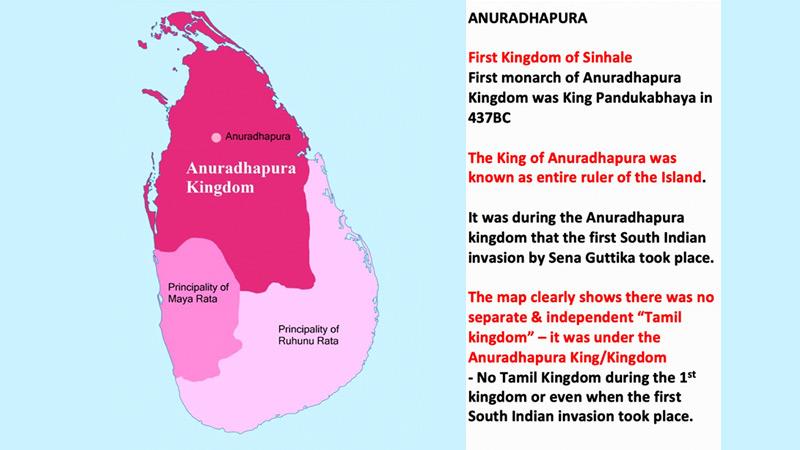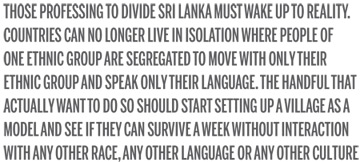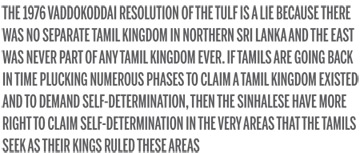
In 1992, a paper was presented by a Working Group of the International Federation of Tamils in London. The paper cites a quote from the British Colonial Secretary in June 1799 to the UK Government while Robert Brownrigg, the Governor of Ceylon refered to Tamil as Malabar Language. Both ethnicity and language of Tamils were identified as Malabars who belonged to South India.
1. Hugh Cleghorn - British Colonial Secretary

When the Portuguese arrived in then Ceylon, there was no Tamil independent nation, therefore, for close to 500 years the so-called Tamil kingdom had no independent Tamil nation. Plucking bits and pieces from history and demanding a separate state is ludicrous and will only create ugly precedents for others to make similar silly claims. Those professing to divide Sri Lanka must wake up to reality. Countries can no longer live in isolation where people of one ethnic group are segregated to move with only their ethnic group and speak only their language. The handful that actually want to do so should start setting up a village as a model and see if they can survive a week without interaction with any other race, any other language or any other culture.
The usage of the term Malabar has not been given due attention.
* Who are the Malabars?
* Where do Malabars come from/originate?
* What is the Malabar language (Tamil)
There answers negate the self-determination quest.
Malabars do not find their origins in Sri Lanka.
Malabars are by ethnicity and language from South India.
South Indian Malabars cannot claim self-determination in Sri Lanka. They should do so in South India.
We have not paid enough attention to this key word – Malabar as this was the term used for “Tamils” by all thee colonial invaders. They used
Malabar to refer to Tamils who came from South India. Nowhere was there any reference to Ceylon Tamils, as this term was coined only in 1911. Prior to 1911, no such people called Ceylon Tamils existed.
Tamils seeking self-determination and separation have previously used the quote by Hugh Cleghorn, however, it is being ignored now primarily because people have been smart enough to ask “who are the Malabars”.
2. Chief Justice Sir Alexander Johnstone
Tamils also used the quote by Chief Justice Sir Alexander Johnstone in July 1827 to the Royal Asiatic Society of UK and Ireland
Chief Justice Sir Alexander Johnstone said that the people who were inhabiting the North and the East of Ceylon:
* Spoke the same language
* Used the same written character
* Had the same origins
* Had the same religion
* Had the same castes,
* Had the same laws
* Had the same manners as that of the people who at the same period inhabited the Southern peninsula of India.
What more is there to say.
Tamilnation.org claims that the “Cleghorn Minute of 1799 and the Arrow Smith Map of 1802 are official proof that the Island of Ceylon consisted of two separate countries”
How can this be – when both refer to Malabars and both confirm Malabars are from India?
Kandyan Convention
It is important to note that the island was ceded to the British via the Kandyan Convention of 1815. The Kandyan Convention was signed between the British and the Sinhale nation represented by the Kandyan Chieftans. Did the British sign a separate convention with the Tamils? No, was there a separate Tamil kingdom during this period? No.
3. British Viscount Rorrington - Malabar Colonisation of Sri Lanka
 Viscount Torrington arrived in Colombo in May 1847. He increased taxes resulting in mass protests. To quell the protests, he brought Malabar troops from Madras. He was known as the British hyena resulting in being recalled from Ceylon. None of these Malabar troops returned to India.
Viscount Torrington arrived in Colombo in May 1847. He increased taxes resulting in mass protests. To quell the protests, he brought Malabar troops from Madras. He was known as the British hyena resulting in being recalled from Ceylon. None of these Malabar troops returned to India.
The 1818 rebellion was also quelled using Malabar Tamils brought in from India. They too didn’t return to India either.
This proves colonial British were transporting Malabars (Tamils) from Indian coast to Sri Lanka and settling them with explicit intent to change the demography of Sri Lanka.
This is Malabar colonisation of Sri Lanka.
This also shows that Malabars initially brought from India to Jaffna were to be sent to the East to colonise the East.
Settlements
“Settlements” indicate the British were not bringing one or two Indians but entire villages to create artificial Malabar “inhabitants”.
The colonial British colonised the North and the East with Malabars (Tamils). These are the descendants now claiming a bogus “homeland”.
Does the TNA ever claim an exact period of independent rule? How can they claim so, if the Sinhalese had been living in the North before them? Can the TNA list names of Tamil rulers who are not Indians?
This is indicated by Mudaliyar C Rasanayagam (a Tamil) who in his book Ancient Jaffna in 1926 stated, “Jaffna was occupied by the Sinhalese earlier than by the Tamils which is seen not only in the place names of Jaffna but also in some habits and customs of the people”.
He said that the population of Jaffna from the earliest times was one of Sinhala speaking people. This changed as a result of South Indian invasions.
Dr. Karthiegesu Indrapala in his doctoral thesis wrote that Tamil settlements existed only after the 13th century.
Prof. K M de Silva in his book “Myth of the Tamil Homelands” said that even between the 10th and 15th century AD, Sinhala settlements were strong in the North – “In the early days when Buddhism flourished in Northern Ceylon, the outlaying islands off the coast of Jaffna contained important monasteries and viharas”.
When the Western colonial invaders arrived with the Portuguese in 1505, historian Father Queroyz in his book “The Conquest of Ceylon” wrote, “On the arrival of the Portuguese that Jaffna was one of the 15 sub-kingdoms under the King of Kotte who was, therefore, known as the Emperor of Ceylon”.
When the Portuguese attacked Jaffna, the Sinhala King sent his troops headed by Mudaliyar Atapattu because Jaffna was part of the Kandyan Kingdom. Queroyz stated that Jaffnapatana “remained under the Portugezen sway for upwards of 40 years, wrested from the Emperor by Philippo d’Olivero when he defeated the Cingalezen forces near Achiavelli (Achuvely) by the great pagoda”.
If when the Portuguese arrived, there was no separate independent Tamil kingdom, how can the Tamil separarists make self-determination claims?
That Buddhist temples, monasteries and ancient remains existed in the North even as far back as the 2nd century BC is revealed in the report to UNESCO by UNP MP Cyril Mathew.
What happened to the Sinhala Buddhists living in Northern Sri Lanka?
Numerous invasions from India after the 13th century led to Aryachakravarti rule forcing Sinhalese to move Southwards for safety.
All three colonial invaders brought Malabars from South India and colonised them in Sri Lanka. Malabar Tamils were the only Tamils who were living in Sri Lanka, it was only in 1911 that a group called Ceylon Tamils emerged.
The Thesavalamai law too is applicable not to Ceylon Tamils but only to Malabar Indian Tamils. It is only applicable to the Malabar inhabitants of Jaffna, and not applicable to Tamils in Trincomalee, Batticoloa, Estate Tamils or non-Jaffna Tamils. This law is not a customary of Tamils but of Indian Tamils.
The three colonial rulers colonised Sri Lanka using Malabar Tamils by enacting wasteland laws making Kandyan peasants landless. If at all anyone should be asking land back, it is the Kandyan peasants who lost their lands as a result of invaders’ illegal laws.
Malabar colonisation by the three Western invaders resulted in close to one million Indian non-citizens bringing in Sri Lanka. These Indians were residing on Temporary Resident Permits. They were regarded separate to the Ceylon Tamils term coined in 1911. How this was separated using what criteria has never been properly explored.
Citizenship Act
The Ceylon Citizenship Act of 1948 allowed Indians who were born in Ceylon to citizenship and 145,000 Indian Tamils gained citizenship which G G Ponnambalam supported. In 1964 and 1974, more Indians were given citizenship in Sri Lanka. These “citizens” were Malabars that the British, Dutch and Portuguese had brought in.
The 1976 Vaddokoddai Resolution of the TULF is a lie because there was no separate Tamil kingdom in Northern Sri Lanka and the East was never part of any Tamil kingdom ever. If Tamils are going back in time plucking numerous phases to claim a Tamil kingdom existed and to demand self-determination, then the Sinhalese have more right to claim self-determination in the very areas that the Tamils seek as their kings ruled these areas and there is enough evidence to prove so.
That the East was part of the Kandyan Kingdom is proved when on May 14, 1638, King Rajasinghe II, King of Kandy travelled to Batticoloa to sign a treaty with Adam Westerwold of the Dutch Navy sealing alliance between the Dutch and the Sinhalese against the Portuguese (Kandyan Treaty of 1638). This treaty was signed 18 years after Sankili was deposed by the Portuguese.
In 1833, the Colebrooke and Cameroon reforms divided Ceylon into five provinces – Nuwara Kalaviya (Present North Central Province) was annexed to the Northern Province while Thamankaduwa (Polonnaruwa) was annexed to the Eastern Province. The British demarcation of provinces was not based on historical habitats, ethnicities or language but for administrative needs and revenue making only. So, these British-created demarcations cannot be used for ethno-religious-language division of Sri Lanka.
Hugh Cleghorn minute
The Tamil separatists have been lavishly using the Hugh Cleghorn minute as a basis to claim a Tamil Homeland. However, this famous minute refers to Malabars and they are descendants from India and do not have origins in Sri Lanka to claim a homeland.
Boatloads of Malabars were brought to Ceylon as written by Captain Robert Percival in his book “An Account of the Island of Ceylon (1805), “the inhabitants of Jaffna consists of a collection of various races. These different tribes of foreign settlers greatly exceeded the number of the native Ceylonese in the district of Jaffna” . (page 71-72)
It is time people start questioning how Malabars can demand self-determination in Sri Lanka or claim “original habitats” as Malabars were transported from South India by the colonials and settled in the North and the East of Sri Lanka. The task is to first separate Malabars from the 1911 coined Ceylon Tamils because if they emerged from Malabars, they have no right to any separate homeland in Sri Lanka.
Enough of these Goebbells’ claims for a separate homeland – prove those demanding a separate homeland are not descendants of Malabars first.
